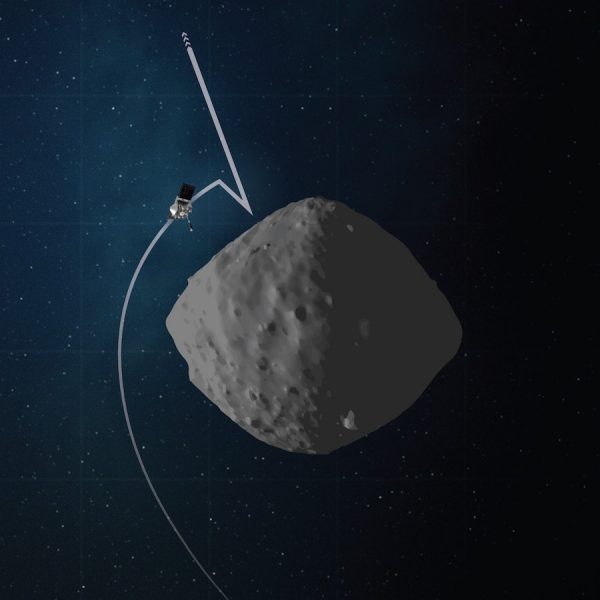OSIRIS-REx spacecraft carries out first of two rehearsals before sampling asteroid – Spaceflight Now

Operating with on-board autonomy more than 140 million miles from Earth, NASA’s OSIRIS-REx spacecraft succeeded Tuesday in a rehearsal for the sample return mission’s touch-and-go landing on an asteroid later this year.
Tuesday’s practice run lasted around four hours, and the OSIRIS-REx spacecraft moved as close as 213 feet (65 meters) from asteroid Bennu, closer than any point since the mission’s arrival at the asteroid in December 2018.
Mission managers approved the Tuesday’s exercise, called the checkpoint rehearsal, to test the spacecraft’s ability to deploy its sampling arm and autonomously approach asteroid Bennu.
In August, OSIRIS-REx is scheduled to approach the asteroid for a touch-and-go landing to collect at least 60 grams, or 2.1 ounces, of material from Bennu’s gravelly surface. OSIRIS-REx will return the samples to Earth in September 2023 for analysis by scientists inside terrestrial labs far more advanced than the instrumentation that can fit on a spacecraft.
NASA’s Origins, Spectral Interpretation, Resource Identification, Security, Regolith Explorer, or OSIRIS-REx, spacecraft has been mapping Bennu with cameras, mineral-sniffing spectrometers and a Canadian-built laser to measure its roughness.
Once the samples from Bennu are back on Earth, scientists will examine the specimens to search for signs of organic matter and other chemicals critical to the dawn of life.
Bennu is a 1,614-foot-side (492-meter) asteroid shaped like a spinning top. The asteroid, and OSIRIS-REx, were located some 143 million miles (230 million kilometers) from Earth as of Wednesday.
Built and operated by Lockheed Martin, the OSIRIS-REx spacecraft launched from Cape Canaveral in September 2016. A limited number of personnel managed Tuesday’s checkpoint rehearsal from a Lockheed Martin control center in Colorado, plus sites at the Goddard Space Flight Center in Maryland and the University of Arizona.
Other team members participated remotely due to the coronavirus pandemic.
OSIRIS-REx began Tuesday’s rehearsal by firing thrusters to break out of a 0.6-mile-high (1-kilometer) orbit around Bennu, then extended the robotic sampling arm, or TAGSAM, that will be used to capture rock specimens from the asteroid. OSIRIS-REx flew on autopilot throughout the decent, using a navigation program called natural feature tracking to compare images taken in real-time by the spacecraft with an on-board image catalog of Bennu’s surface.
The comparison yielded precise fixes of the spacecraft’s location relative to the asteroid, guiding OSIRIS-REx through a narrow descent corridor toward Bennu.
OSIRIS-REx later turned to the attitude, or orientation, for the final descent to the asteroid and adjusted its two solar array wings to a “Y-wing” configuration to safely position them away from the asteroid’s surface.
After a final navigation update from the landmark tracking program, OSIRIS-REx pulsed its attitude control rocket thrusters for around three seconds to begin a slow-speed fall from a distance of 410 feet (125 meters). That’s the so-called checkpoint burn during the descent sequence.
OSIRIS-REx’s cameras and some of the craft’s science instruments collected data during the descent, just as they will during the real sampling attempt later this year.
After nine minutes, at a distance of 213 feet (65 meters), the spacecraft fired its thrusters again to back away from the asteroid.
The images below were taken over a 10-minute span between the checkpoint burn and the completion of the back-away maneuver. The spacecraft’s extended Touch-And-Go Sample Acquisition Mechanism, or TAGSAM, arm is visible in the center of the animation.
For scale, scientists say the boulder coming in from the upper right of the image frame is the size of a two-story house.
Credit: NASA/Goddard/University of Arizona
After the end of the back-away burn, the spacecraft’s solar arrays returned to their normal orientation, and the TAGSAM arm was folded back into its parked configuration as OSIRIS-REx climbed back into orbit around Bennu.
“This rehearsal let us verify flight system performance during the descent, particularly the autonomous update and execution of the checkpoint burn,” said Rich Burns, OSIRIS-REx project manager at NASA’s Goddard Space Flight Center. “Executing this monumental milestone during this time of national crisis is a testament to the professionalism and focus of our team. It speaks volumes about their ‘can-do’ attitude and hopefully will serve as a bit of good news in these challenging times.”
On June 23, OSIRIS-REx will perform another rehearsal and descend closer to Bennu. During that exercise, the spacecraft will descend through the so-called “matchpoint” burn and reach a position just 82 feet (25 meters) from the asteroid before again backing away.
If all goes according to plan, the spacecraft will make its first real sampling run Aug. 25.
The primary target site for the touch-and-go landing has been designated Nightingale.
The Nightingale site is located inside a 460-foot (140-meter) crater on Bennu, but the area deemed safe for the spacecraft to touch is 52 feet (16 meters) across. That is about one-tenth the size of the safe sampling area scientists expected before OSIRIS-REx arrived at Bennu.
The asteroid is more rugged than scientists expected. OSIRIS-REx is the first mission to get an up-close view of Bennu.
The Nightingale site appears to have an abundance of fine-grained material within the capability of the OSIRIS-REx sampling mechanism. It appears dark, suggesting it might harbor relatively high concentrations of carbon, the building block of organic molecules, scientists said.
A device mounted on the end of the spacecraft’s TAGSAM arm will contact the asteroid surface and fire compressed nitrogen gas. The gas cartridge will disrupt the rock at the sampling site, and the spacecraft will capture some of the material in a chamber for return to Earth.
If the first sampling attempt turns up empty, scientists have penciled in opportunities for additional tries later this year.
Under OSIRIS-REx’s current flight plan, the spacecraft will depart Bennu next March to begin the return trip to Earth.
OSIRIS-REx will release a return capsule protected by a heat shield to plunge into Earth’s atmosphere and parachute to a landing in Utah on Sept. 24, 2023.
Email the author.
Follow Stephen Clark on Twitter: @StephenClark1.






